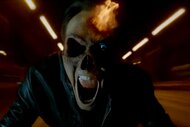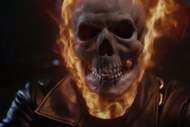Create a free profile to get unlimited access to exclusive videos, sweepstakes, and more!
Erik Killmonger's latest comic saga is dark, dramatic, and action-packed

Black Panther has taken over the universe since the movie made its debut last February. One of the most discussed and dissected characters of the film is its antagonist, Erik Killmonger. Like most villains, he’s a complicated person with misguided ideologies and morally skewed solutions to valid problems. Killmonger, played to perfection by Michael B. Jordan, not only inspired endless online debates and analytical essays, he also birthed Marvel’s latest Killmonger comic miniseries, which focuses on his life prior to arriving at Wakanda. Killmonger released its fifth and final issue in March 2019, completing an engaging, nuanced, and action-packed story about this MIT graduate’s thirst for rage and revenge.
The comic series borrows from the movie in several ways, including Erik’s general appearance (notably his hair) and several recognizable lines, but this narrative is undeniably unique in comparison to the character’s arc in the film. Honestly, the movie references didn't feel necessary, because this work stands pretty solid on its own. Erik’s backstory has shifted, but his basic motivations are essentially the same — get to Wakanda and claim the throne.
Writer Bryan Edward Hill (Cyber Force, Postal) quickly establishes Erik’s motivations as well as his personality traits to set the action in motion. Erik is undeniably cunning, brutally honest, and singularly focused on what he believes is the right mode of action in any situation. There are still undertones of his misogyny from the film that permeate through some of his interactions with women, as well as in moments when he lowers his emotional guard for a comrade. His determination for revenge is fueled by a series of betrayals as well as an unexpected connection he makes to Wakanda.
Basically, this guy is a ball of confusion who allows anger and toxic bravado to govern his every move. Yet it’s extremely entertaining to watch him in action and follow along as he links up with the wrong set of mercenaries. Killmonger’s downward spiral feels exceptionally tragic because he has been failed by so many people in his life, as well as his own ego.
Several iconic comic characters, like Kingpin and Black Widow, tie brilliantly into the storyline for a fast-paced, brutal ride that will keep readers on edge until the end. Black Widow is by far one of the more interesting additions to this story, but she still feels underulitized. The battle fans want to see never comes to fruition. Wakandan history is interwoven throughout Killmonger without weighing down the story’s pacing, but readers may want to give its panels a double take to truly absorb all that detail.
The ending leaves a lot for interpretation and begs for a continuation of this journey. Aesthetically, Juan Ferreyra (Old Man Logan, Green Arrow) masterfully brings this series to life with gorgeous artwork that wholly encompasses Hill’s emotionally complex and rugged story. Each panel practically leaps off the page with a wonderful vibrancy as he captures the essence of the characters, and Ferreyra’s artistic takes on flashbacks and images of Wakanda deities are nothing short of fantastic.
Overall, Killmonger is a comic worth picking up all the issues to binge-read the story of how a Wakanda boy named N’Jadaka was ripped from his rightful home and made his way back around via the darkest path possible.



























